Merope, also designated as 23 Tauri, is a star in the zodiacal constellation of Taurus, and a member of the famous Pleiades star cluster.
Key Facts & Summary
- Merope is among the nine brightest stars in the gigantic Pleiades star cluster.
- Merope is at 380 light-years away from the Sun, it is much closer to us than most other Pleiades stars.
- Merope is a bluish-white B-type subgiant of spectral type B6IV(e).
- It is also classified as a Beta Cephei type variable star since its brightness varies by 0.01 magnitudes.
- Out of the stars representing the Seven Sisters, Merope is the faintest among them.
- Merope has an apparent magnitude of 4.18, and its absolute magnitude is uncertain.
- This star has a radial velocity of around 6.2 kilometers / 3.8 miles per second.
- Merope has around 5.1 solar radii and about 4.5 solar masses – thus it is much more bigger than our Sun.
- Merope is the fourth biggest star out of the ones representing the Seven Sisters.
- The star has a surface gravity of 4.0 cgs.
- Merope’s surface average temperatures have been estimated at around 13,360 K.
- The zodiacal constellation of Taurus and the Pleiades open cluster are visible enough, that they have been known to the ancients.
- The Pleiades cluster is very bright, though, it cannot be seen during May and June since the Sun blocks our view of the cluster in that period.
- Merope appears to be a single star, however, it is enveloped by a nebula designated as NGC 1435, similar to the star Maia, which is itself also enveloped by a nebula.
The star Merope is named after one of the Pleiades, the seven daughters of the Oceanid nymph Pleione and the Titan Atlas, in the Greek mythos.
Merope was the youngest of the seven daughters and the only one to have married a mortal. Her husband was Sisyphus, the king of Ephyra, who was condemned to roll a large boulder up a hill for eternity as punishment for his deceitfulness.
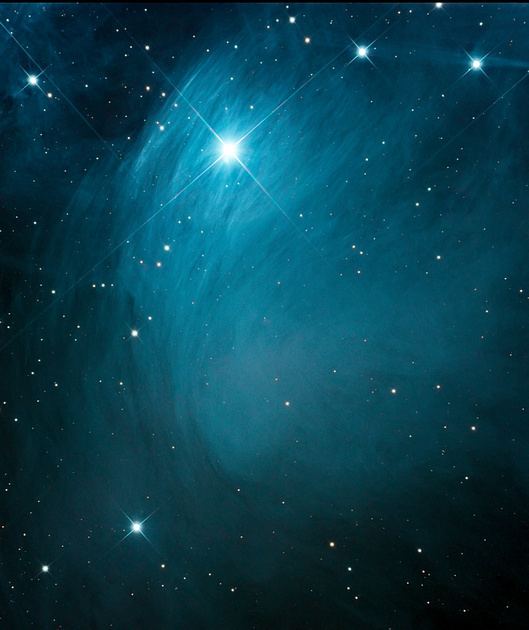
Merope is also referred to as the “Lost Pleiade” since it is the faintest of the seven stars representing the Pleiades and thus not as easily seen as the others.
Formation
Merope, along with its neighboring stars in the Pleiades cluster, formed between 75 and 150 million years ago. This open cluster is among the closest star clusters to Earth.
All the stars in the Pleiades cluster have a common origin, they formed through a gigantic molecular cloud of dust and gas. Gravity pulled the swirling gas and dust together and formed the Pleiades cluster.
The Pleiades cluster is overall dominated by very hot blue and luminous stars.
Distance, Size, and Mass
Merope is situated at around 380 light-years / 117 parsecs away from the Sun, with an estimated error of about 20 light-years / 5 parsecs.
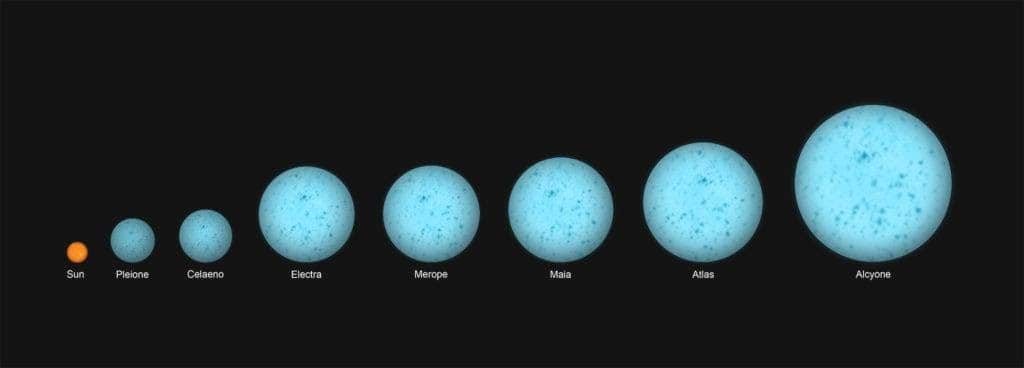
Merope has around 5.1 solar radii, or 510% the Sun’s radius and about 4.5 solar masses, or 450% of the Sun’s mass. Based upon its radius, Merope’s diameter would have to be around 10 times bigger than the Sun’s.
Other Characteristics
Merope is a bluish-white B-type subgiant of spectral type B6IV(e). The surface average temperatures on Merope have been estimated at around 13,360 K, it is 2.3 times hotter than our Sun.
Merope is also 630 times brighter than our Sun, and the star has a rotational speed of at least 280 km / 173.9 mi per second at the equator, this insanely fast!
This star has an apparent magnitude of 4.18. Merope is also classified as a Beta Cephei variable, showing variations in the brightness of 0.01 magnitudes.
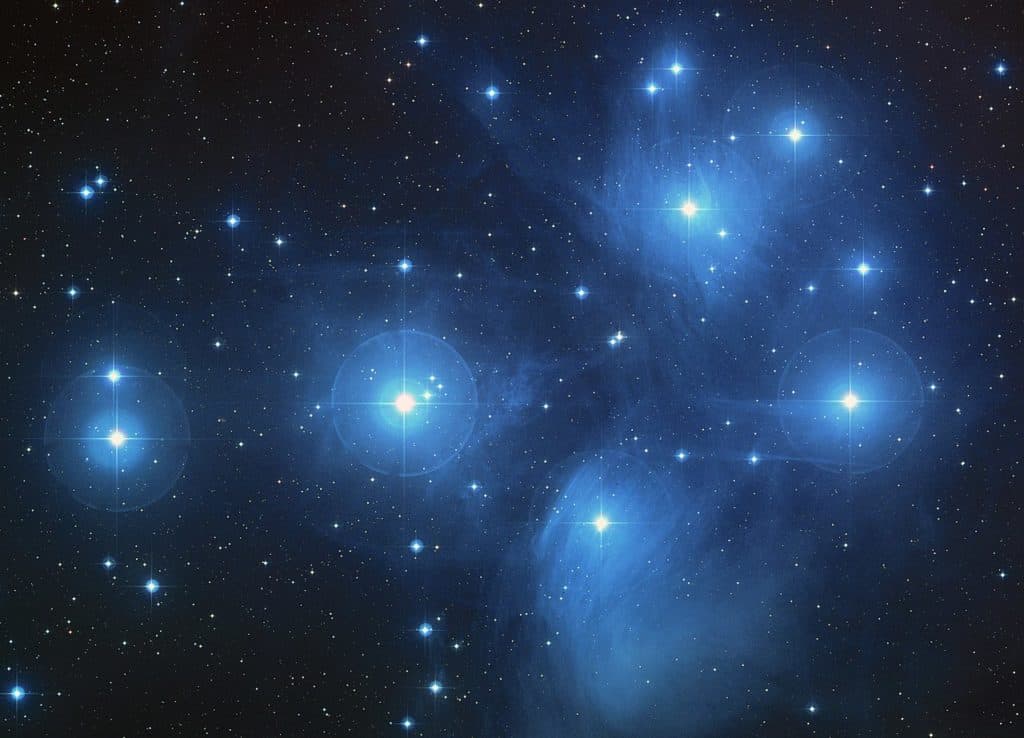
This type of variable stars often belongs to the spectral class B, and they exhibit small yet rapid changes in brightness as a result of pulsations of their surface.
Among the best examples of other Beta Cephei variable stars are Mimosa, Hadar, Spica, Shaula, Mirzam.
Merope Nebula
This Perseid star is enveloped by a nebulosity cataloged as NGC 1535. The nebula is also named after Merope and sometimes it is referred to as Tempel’s Nebula – in honor of the German astronomer, Wilhelm Tempel, who discovered it in 1859.
The diffuse reflection nebula is the brightest around Merope, where it has an apparent magnitude of 13. The rest of the nebula is fainter than magnitude 16.
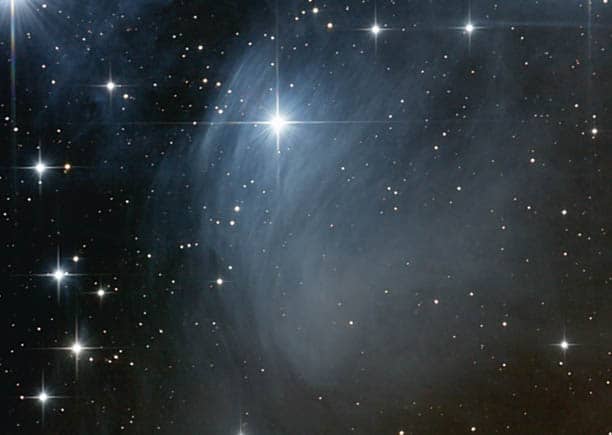
The Merope Nebula is also part of a larger nebulosity that envelops the Pleiades, which is a huge interstellar dust cloud through which the Pleiades stars are passing through.
This cloud is actually dispersed by the star’s passage. The nebula contains a bright knot, designated as IC 349, and located 36” northwest of Merope.
The knot is almost half an arcminute wide. It was discovered by Edward Emerson Barnard in 1890, an American astronomer, and it is also known as Barnard’s Merope Nebula.
Location
Merope is located in the zodiacal constellation of Taurus, the celestial bull. This constellation is among the 48 Greek constellations first listed by the Greco-Roman astronomer Ptolemy, in the 2nd century CE.
Merope is among the brightest stars of the famous Pleiades open cluster, which is situated in the Taurus constellation. The Constellation of Taurus is also home to another great open cluster named Hyades.

This constellation is among the largest in the night sky, and also one of the most prominent of the northern constellations occupying an area of 797 square degrees.
The constellation of Taurus, apart from the two mentioned clusters, also has many interesting stars such as Aldebaran, Elnath, and also other fascinating deep-sky objects such as the Crab Nebula, Crystal Ball Nebula, merging galaxies and many more open clusters.
These celestial objects are best observed and studied during January.
Pleiades Member
Merope is among the nine brightest stars of the Pleiades open cluster. From October to April, these stars can be observed and studied, however, May and June are not suitable for observation since the cluster is too close to the Sun.
The Pleiades open cluster is among the closest star clusters to Earth, and one of the brightest in our vicinity. Though the cluster is very bright and easy to find, you may also draw an imaginary line from the stars of Orion’s Belt – Alnitak, Alnilam, and Mintaka – past Aldebaran – and find the cluster.
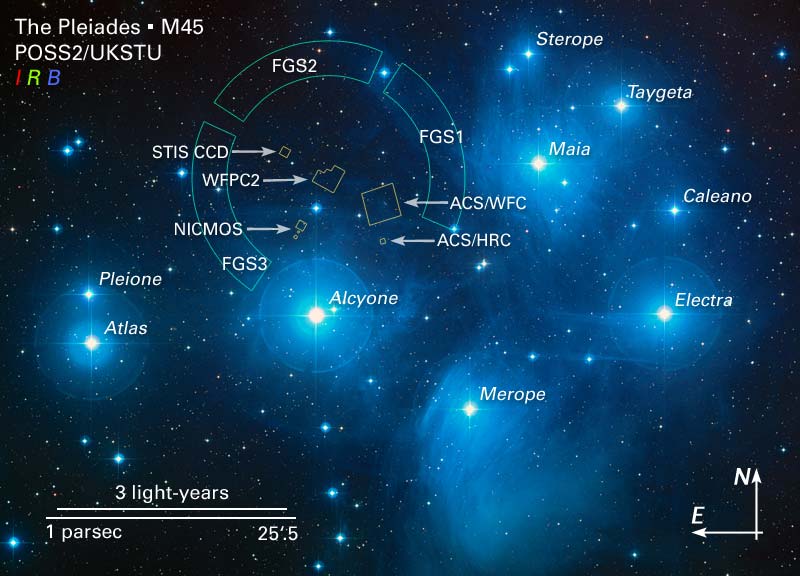
The Pleiades cluster is also known as Messier 45. The majority of the brightest and hottest stars here are of spectral class B, and they formed between 75 and 150 million years ago.
Most of them are far apart from each other, and at around 444 light-years away from us. The most documented and famous stars are all named after the mythological Seven Sisters and their parents from Greek mythology.
The nine stars are Alcyone, Asterope, Atlas, Electra, Celaeno, Maia, Merope, Taygeta, and Pleione. The mythological story depicts the sisters as they caught the eye of Orion, a giant huntsman. Atlas, being condemned for his battles against the gods, was condemned to carry the heavens on his shoulders while Orion, the giant, pursued his daughters.
However, the Greek god Zeus stepped in and transformed the sisters into doves, and then into stars to console their father. Even so, Orion, the giant, is still pursuing the Pleiades sisters across the sky, represented by the Orion constellation.
The Future
Merope will continue to exist for many millions of years however, the Pleides star cluster has been studied closely and many computer simulations predict a grim future.
Most simulations suggest that the cluster will continue to survive for 250 million years before it will start to disperse due to gravitational interactions with its galactic neighborhood.
Did you know?
- In the Harry Potter series, author J.K. Rowling used many star names for her characters. Merope is one such name, given to the main antagonist’s mother – Merope Riddle, mother of Lord Voldemort.
- The Chinese know Merope as the Fifth Star of Hairy Head – Hairy Head being an asterism formed by the Pleiades stars Asterope, Atlas, Electra, Maia, Merope, Taygeta, and Alcyone.
- The Pleiades star cluster is believed to have been formed from a compact configuration that resembled the Orion Nebula.
- Many cultures throughout the world knew of the Pleiades cluster since ancient times. One of the earliest depictions of the Pleiades cluster and its stars resides in the Nebra sky disk – a Bronze Age artifact dating to 1.6000 BCE, uncovered in Germany.
- Many famous and ancient texts mention the cluster, such as Homer’s Illiad and Odyssey, Hesiod’s Works and Days, the Bible, the ancient Egyptian Calendar of Lucky and Unlucky Days, and the Japanese Kojiki – An Account of Ancient Matters – the 8th-century chronicle of myths, oral traditions, and legends.
- The Pleiades are mentioned in the Kojiki as the Mutsuraboshi – translating to “six stars.” In modern Japan, the cluster is now known as Subaru – the same name used by the famous automobile company that depicts the six brightest stars in their logo.
- One of the first telescopic observations conducted on the Pleiades was during the 1610s. Galileo Galilei observed the bright stars and the cluster and it is noted that he may well be the first to have done so.
Sources:
Image sources:
- https://alchetron.com/cdn/merope-star-f407edf3-ac95-4025-a83d-70726394cf9-resize-750.jpeg
- https://upload.wikimedia.org/wikipedia/commons/thumb/4/4e/Pleiades_large.jpg/1280px-Pleiades_large.jpg
- https://skyandtelescope.org/wp-content/uploads/Merope-Nebula-Hap-Griffin-ST.jpg
- https://www.star-facts.com/wp-content/uploads/2019/10/Taurus-constellation.jpg?189db0&189db0
- https://upload.wikimedia.org/wikipedia/commons/e/e1/M45map.jpg
